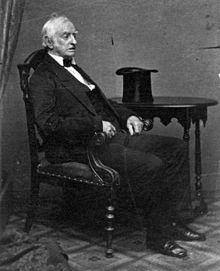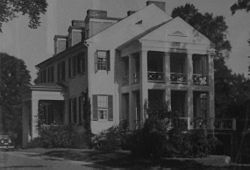Richard Sprigg Steuart: Difference between revisions
cleanup |
war of 1812 |
||
| Line 14: | Line 14: | ||
==Early Life== |
==Early Life== |
||
Steuart was born in Baltimore in November 1797, younger son of the physician Dr James Steuart, and was educated at St Mary's College. During the [[War of 1812]] he volunteered his assistance to the company of his brother, [[Major General |
Steuart was born in Baltimore in November 1797, younger son of the physician Dr James Steuart, and was educated at St Mary's College. During the [[War of 1812]] , aged just fifteen, he volunteered his assistance to the company of his older brother, Captain (later Major General) [[George H. Steuart (Major General)|George H. Steuart]] (1790-1867), and served at the [[Battle of North Point]], where his father was also present as Commissary.<ref>Nelker, 136, Memoirs of Richard Sprigg Steuart.</ref> As he later recalled in his memoirs: |
||
:"I found my little knowledge of surgery very useful. One of the soldiers had been shot through the thigh wounding the remoral artory, so...I made a tourniquet, arresting the flow of blood, to place him in my wagon and bring him to the Maryland hospital. Here surgeon Gibson received him and finally amputated his leg."<ref>Nelker, 136, Memoirs of Richard Sprigg Steuart.</ref> |
:"I found my little knowledge of surgery very useful. One of the soldiers had been shot through the thigh wounding the remoral artory, so...I made a tourniquet, arresting the flow of blood, to place him in my wagon and bring him to the Maryland hospital. Here surgeon Gibson received him and finally amputated his leg."<ref>Nelker, 136, Memoirs of Richard Sprigg Steuart.</ref> |
||
Revision as of 15:43, 31 July 2009
Richard Sprigg Steuart | |
|---|---|
 Photograph of Richard Sprigg Steuart | |
| Born | 1797 |
| Died | 1876 |
| Occupation | Physician |
| Spouse | Maria Louisade Bernabeu |
Dr Richard Sprigg Steuart (1797-1876) was a Maryland physician and an early pioneer of the treatment of mental illness. He was instrumental in the expansion and modernisation of The Maryland Hospital for the Insane, now known as the Spring Grove Hospital Center. Spring Grove continues to treat mental illness today, and is the second oldest institution of its kind in the United States.
Early Life
Steuart was born in Baltimore in November 1797, younger son of the physician Dr James Steuart, and was educated at St Mary's College. During the War of 1812 , aged just fifteen, he volunteered his assistance to the company of his older brother, Captain (later Major General) George H. Steuart (1790-1867), and served at the Battle of North Point, where his father was also present as Commissary.[1] As he later recalled in his memoirs:
- "I found my little knowledge of surgery very useful. One of the soldiers had been shot through the thigh wounding the remoral artory, so...I made a tourniquet, arresting the flow of blood, to place him in my wagon and bring him to the Maryland hospital. Here surgeon Gibson received him and finally amputated his leg."[2]
After the war, Steuart began his study of medicine in earnest under Sir William Donaldson in 1818, graduating in 1822. Early on he began to specialize in the relatively neglected field of mental illness, while maintaining a substantial general medical practice in Baltimore.
Maryland Hospital for the Insane
His most notable contribution to the field of mental illness was his work for the Maryland Hospital for the Insane (originally founded in 1797), where he became President of the Board and Medical Superintendent. By the mid-nineteenth century The Hospital's bed capacity was no longer adequate, and Steuart managed to obtain authorization and funding from the Maryland General Assembly for the construction of the new facility at Spring Grove. He chaired the committee that selected the Hospital's present site in Catonsville, and he personally contributed $1,000 towards the purchase of the land in 1853. [3]
Dodon and the question of slavery


In 1842 Steuart gave up his general medical practice in order to concentrate on farming the family estate which he inherited at Dodon, Maryland, comprising around 1600 acres of land and about 150 slaves.[4] Like many Southern slaveholders, Steuart held conflicting views on the question of slavery. Although he recognized that the South's "peculiar institution" could not continue indefinitely, he was hostile to the Abolitionists' attempts to end it by forceful means.
In an open letter to John Carey in 1845, published in Baltimore by the printer John Murphy, Steuart set out his views in considerable detail. He begins by considering the baleful effects of slavery on his home state of Maryland:
- "Is there a man in Maryland, is there a single man connected with slavery who does not feel its existence to be a curse upon our beautiful land? Is there one who has not many a time...expressed a fond hope that he might live to witness the consummation of its extinction, and the entire exodus of the negro race from among us? If there is such a man, I have never met with him here...indeed it is impossible for a man of sound judgment and feelings...to behold the power and prosperity of Pennsylvania and Ohio, for instance, in comparison with our own state, and not feel the deepest regret for our deficiencies."[5]
Steuart was envious of the greater relative prosperity of the Northern States, and especially their much greater population growth. In Maryland, he argues, slavery held back economic progress:
- "It is a matter of common observation that white laborers will not settle where slaves occupy the soil, however partially they may do so among free negroes. The white man shrinks from a union of labor with those who are regarded by their masters as an inferior race, and gradually he comes to regard labor itself as degrading, and fit only for those whom heaven has stamped with a color darker than his own."[6]
Much though he may have opposed the institution of slavery in principle, Steuart was strongly opposed to the radical agenda of the Abolitionists. Instead, he recommended voluntary emancipation by the slave holders themselves. His opinion of the slaves themselves may, at best, be described as paternalistic:
- "The time has now come...to allow emancipation to progress by the natural course of circumstances, I mean at the pleasure of the slaveholder, unrestrained by legislative enactments or by popular prejudice. As to the negroes, the poor timorous wretches feel and know our power too well to think of aught else than patient, humble submission. We have our foot upon their necks, and they can never rise until we give them leave; and, so long as we are compelled to hold them in slavery, they must beheld with a strong rein and by a strong hand."[7]
Steuart's proposed solution to the problem of slavery was repatriation to Africa. In his letter to Carey, he concludes as follows:
- "The colored man [must] look to Africa, as his only hope of preservation and of happiness...it can not be denied that the question is fraught with great difficulties and perplexities, but...it will be found that this course of procedure...will...at no very distant period, secure the removal of the great body of the African people from our State. The President of the Maryland Colonization Society points to this in his address, where he says "the object of Colonization is to prepare a home in Africa for the free colored people of the State, to which they may remove when the advantages which it offers, and above all the pressure of irresistible circumstances in this country, shall excite them to emigrate."[8]
Civil War
The outbreak of the Civil War in 1864 found Steuart sympathetic to the Southern cause, though Maryland did not secede from the Union (pre-war loyalties in Maryland were divided between North and South, but the Northern cause prevailed). Horses were raised and trained at Dodon then smuggled south for Confederate forces, as well as medical supplies such as quinine. As a result, Dodon was often raided by Union troops, frequently forcing Steuart to flee into hiding.[9] As a family member later recalled:
- "Dr Steuart was constantly away from home, avoiding the raiding parties from the Northern soldiers who sought to capture him, because of the help he gave the South by secretly sending supplies of quinine, and other necessities...to the Southern hospitals. Wakened...in the dead of night, [Maria] dressed quietly and...admitted the Northern soldiers, and then stealing past the sentires, walked half a mile to the 'quarters', and sent a trusty messenger to warn his master not to return. Old Williams Hawkins, when a soldier put a pistol to his head saying 'tell us where your master is', replied 'I'd rather be dead than tell'."[10]
Steuart's support for the Confederacy came at a high price. He was relieved of his duties at the Hospital after he refused to sign an oath of loyalty to the Union. He was however eventually reinstated in 1868, and he was Superintendent when the Hospital moved its operations to Spring Grove in 1872.[11] However, to this day, no building at Spring Grove Hospital Center bears his name.
Family
On January 25 1824 Steuart married Maria Louisa Bernabeu (1800-1883). They had nine children. [12] He died on July 13 1876 and is buried at his family estate of Dodon in Maryland. [13]
External links
- Official Dodon website and history of the estate
- History of Spring Grove Hospital Center
- Letter to John Carey by Richard Sprigg Steuart on the subject of slavery
References
- Richardson. Hester Dorey, Side-Lights on Maryland History: With Sketches of Early Maryland Families, Genealogical Publishing Com, 1995, ISBN 0806302968, 9780806302966.
- Nelker, Gladys P., The Clan Steuart, 1970.
- Steuart, Richard Sprigg, "Letter to John L. Carey on the Subject of Slavery", Published by J Murphy, 1845. ASIN: B00089CM7M
Notes
- ^ Nelker, 136, Memoirs of Richard Sprigg Steuart.
- ^ Nelker, 136, Memoirs of Richard Sprigg Steuart.
- ^ History of Spring Grove Hospital
- ^ Nelker, 150
- ^ Richard Sprigg Steuart, Letter to John Carey 1845, at | page 4.
- ^ Richard Sprigg Steuart, Letter to John Carey 1845, at | page 5.
- ^ Richard Sprigg Steuart, Letter to John Carey 1845, at | page 8.
- ^ Richard Sprigg Steuart, Letter to John Carey 1845, at | pages 10,11.
- ^ Nelker, 150
- ^ Nelker, 150, Letters of the Steuart Family.
- ^ History of Spring Grove Hospital
- ^ Nelker, 70
- ^ Nelker, 70
